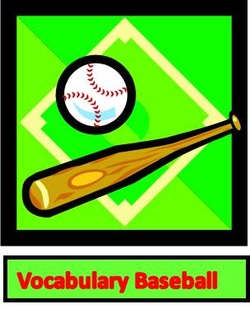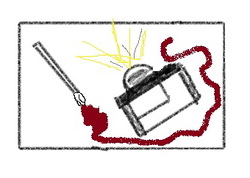 Please be advised that we need to flex our creative muscles tomorrow and use the downstairs portion of the church for our classes. The church is hosting an outreach program next week and needs access to the upstairs. You may still enter the east side of the church -- instead of going up the stairs, please proceed straight through the door in front of you -- one of us will be there to tell your student(s) where to go. Happy Monday!  This week I provided students with an overview of the differences between convergent and divergent thinking. We discussed the importance (and inter-related nature) of both types of thinking skills for the development of strong critical thinking ability and problem solving. Students were then given several exercises to work on in small groups, aimed primarily at flexing their divergent thinking muscles. At first glance these seemed like simple, almost silly questions: 1) list all the possible uses you can think of for a screw driver; 2) the answer is 20, what is the question? However, the purpose of these types of exercises is to get students to e-x-p-a-n-d their thinking, use their imagination, and tap into the more creative problem solving side of their mind. Unlike convergent thinking, where we aim to zero in on one correct answer, divergent exercises such as these help us learn to generate many plausible solutions, and they push us to think more flexibly. Our lead-in exercise this week challenged the students to use scissors to cut a hole in an ordinary piece of paper through which an elephant can pass. Amazingly, what at first seemed impossible (or some sort of trick question!) ended up being solved, as the students talked it through, and asked questions, until obvious and simple statements such as “we need to make the paper really big” led to insights, which ultimately led to a successful procedure: “We can cut strips up and down inside the paper to make one huge hole!”. While we did not have time for all the students to create the enormous paper hoops, I was genuinely impressed with their collective ability to think through such a difficult and unusual problem. And as promised, the step-by-step instructions for cutting the paper are provided below. We also spent some time going over the homework problems from last week. These were very challenging, and I commend the students for the amount of time they devoted to working through them. Not everyone arrived at a solution for each problem, but it was clear to me that everyone had taken time to really think through possible approaches and answers. It is very valuable for the students to deeply engage in the thinking process, even if they do not obtain a solution to the problem. It is also important for them to articulate what approaches/strategies they tried and what process led to a solution for each problem. Some important observations the students made on thinking processes this week include the following: the solution to problem 1 (bacteria) becomes simple and obvious once you realize it is a problem of doubling - the initial amount of bateria in the cup is irrelevant, although students felt at first that it must somehow be important to the solution; problem 2 sounds impossible and confounding, until we have the realization that we need as much time to pass as possible between the uttering of the sentence and Peter's next birthday - then we can easily solve it by visualizing a calendar; problem 3 requires the most divergent thinking, as we must conceive that circles could be drawn on both sides of the paper (and the class even came up with several other plausible answers!); problem 4 (the magic square) requires the process of elimination and several iterations to arrive at the solution. I provided the students with three new problems to work on at home this week. These are similar to last weeks problems - tricky but fun! Read them over carefully and take your time thinking them through. I look forward to hearing your solutions and thought processes on Monday!
 In class this week students eagerly shared their thoughts on the first few chapters of the novel. We enjoyed discussing all the humorous and challenging obstacles Shirley faced when she first came to America and began life at her new school. We talked briefly about what it means to be an “ambassador” and in what ways Shirley is an ambassador for China. All students had a chance to read aloud the answers to their homework journaling questions from last week, and we learned a bit more about each other as everyone explained the new name they would choose to represent themselves - just as Bandit did before she left for America. Students then split into two teams (The Jackie Robinsons and The Three Cousins), determined their line-up, and played a rousing game of “Vocabulary Baseball”. Each player up to bat was “pitched” one of the week’s vocabulary words in various forms (definition, sentence/context, synonym), with a correct answer resulting in a base hit. The list of words was long and challenging and I was very impressed with the obvious time the students had spent familiarizing themselves with the meanings. We had many hits and several exciting instances of bases loaded, but no runs scored…yet. We look forward to continuing the game next week, with new words! Next week in class we will begin creating a Character Collage, or visual representation, of Shirley. Students should bring to class several items to add to the collage. These may include pictures, drawings, maps, words, fabric/material, or most anything that can be added to our poster board to illustrate the setting of the story, Shirley’s personality, challenges, and activities in the story. Everyone seemed comfortable with the amount of reading (three chapters) assigned last week. This week we will aim for reading the next four (April – July). I provided the students with a homework handout with new vocabulary words to learn and a journal question to write about. Also, please have them continue to fill in Event/Changes log for each chapter/month and record Shirley’s progression through the novel. Happy Reading! See you next Monday!  This week, our CTC I group (ages 8-10) spent time wondering about "strange statements!" Some of the areas covered were statement analysis, syllogisms and paradoxes. We ended the day playing with some brain teasers. Your child was sent home with a list of twelve "problems" -- we answered eight problems in class. Please have your student play with possible answers for numbers nine through twelve. We will reveal suggested answers for these problems on Monday! Along these lines, you may want to check out the following LINK. The web-site lists 99 different optical illusions -- children often have fun with these. If time is limited, I recommend playing with this illusion. This is one that a student could easily play with on his own, although you may need to read through the instructions one time with your child. I would like the students to connect our last class to optical illusions, in other words, they should consider what do optical illusions and some of the "strange statements" we made on Monday have in common? I will ask them next week if they have come to any conclusions! Next week, we will be playing with pentominoes (see above) for most of the class. If any student has extensive experience with solving pentomino problems -- please let me know!  Sample tile Sample tile Today brought another action-packed and information-filled class. The real work is now beginning, so it's critical that your students be on top of their homework assignments, as all of it relates to the eventual distribution of our first issue on November 12th. Today's topics were; headline creation, the inverted pyramid style of writing, the criteria for selecting a newsworthy story, what purposes do publications serve, and developing interviewing skills. In one activity, the students were asked to pull a random item from their lunch boxes or backpacks and interview that item using only open-ended questions. Creating open-ended vs. close-ended questions proved to be more challenging than we thought, but in the end, the students came up with some really creative queries! Next week, the students will be interviewing a special guest! We are honored to be hosting a visiting relative of one of our students whose resume includes; professional staff writer for a weekly community newspaper in California, time as the managing editor for a company that publishes community magazines, and independent freelance writer/editor. She also publishes a quarterly literary arts journal. Our guest will be speaking about her experiences in writing and publishing, after which, each student will ask an open-ended interview question. This interview may be published in our first issue of The Mosaic Monthly! Here are the items your students need to be working on this week:
 We are off and running in our Creative Thinking Circle! We had a fun and productive first day, and it was wonderful to see everyone together again at our new location. The students worked together to build a definition of "thinking", and then we discussed (and drew) our initial ideas of what nurtures deep thinking and what hinders it. Both of these posters will remain in our classroom and we will add to them as the semester (and our ideas!) progress. The students then worked through a few introductory problems, individually and in pairs. I look forward to digging deeper into the problem sets with them next week. Each student received a homework handout which they should complete by next week. There are only four problems, but they require some thought. I am less interested in having them get the problems "right" as I am in having them take the time to think through various solutions and play with the possibilities. Please encourage them to mull these over - I have explained to them that I would like to know their final answers as well as hear about the thought processes they used to come up with them.  We are off to a great start in our Literature class! I introduced the students to our first book selection, "In the Year of the Boar and Jackie Robinson". We discussed some interesting facts about China, found Bandit's home, Chongqing, on the globe, talked a bit about the Chinese New Year, and looked at the Chinese calendar and animals. Students shared their opinions about what makes a "good book" which opened the door for us to begin looking at some of the basic literary elements we will be covering in class - setting, plot, theme, and characterization. We wrapped up our time together with the children using Chinese calligraphy paint brushes to write their names, translated into Chinese characters. Each student received a homework handout which indicates what needs to be completed by next Monday - assigned chapters to read, several small writing assignments, and a list of vocabulary words they should be familiar with by next week. I have assigned the first three chapters for reading and I will use this first week to gauge how quickly we should move through the book - I know students are at varying reading levels and this is most likely not the only reading on their weekly agenda. I will hope to move at a pace that is most enjoyable and reasonable for all. We had a fantastic first journalism class on Monday. Even though we accomplished a lot, I did not get as far as I thought we would in my lesson plan, thus, there will not be much homework this week. We needed to spend some extra time on planning out our first issue and assigning reporting and editing jobs, so it was time well spent.
Your student has been assigned a writing (reporting) job, or an area of speciality (weather, comics, photography, etc.) and will also be editing another student's work. We will be doing at least one more issue before the semester is over (three, if we're really good!) so we will definitely be rotating staff positions, in order to give as many people as possible some great writing opportunities. In addition, we will be writing in class and also at home, outside of the articles being created for our newspaper, The Mosaic Monthly (named by the kids!) On Monday we talked about several things, including, "What is news?" and "Why is the front page so important?" Every week, they will add five new words to a section in their notebooks called J-Jargon. Make sure they are comfortable and familiar with these terms. I want to challenge them to use these terms when they are working with their classmates on The Mosaic Monthly. A large portion of the material I am using comes from www.hsj.org. The web-site contains archived lesson plans from both public and private high schools throughout the country. The lessons we are using are for grades 9-12. I know they are more than capable of processing this level of material, and honestly, their creativity probably exceeds my own. Very exciting stuff! For homework, we are designing our newspaper "flag." Please remind them to either come up with an idea for the flag or just a portion. Also, we need questions (anonymous are fine) for our advice columnist. Please have them bring one question, type written, to be handed in on Monday.  We had a very interesting and fun first class together on Monday! Some of the topics we covered were problem diversity, multiple solutions, hidden assumptions, and diagrams (including stock and flow). We attempted to define "thinking" and "not thinking." The consensus seemed to be that it is never possible to not think, as the very act of not thinking, is in itself…thinking. Good stuff! In addition to several hands-on problems and questions, we started the Math Lab handout on patterns. If your student didn't get a chance to finish, please have them do this at home. If you can, try to resist helping until the student has exhausted several attempts at a solution. I also passed out a tangram puzzle (that students should cut out) along with a challenge sheet 1. The tangram puzzle is said to have been invented in China, possibly thousands of years ago. The object is to arrange the seven pieces into various shapes by just looking at the outline of the solution. The translation from the original Chinese name literally means, "seven boards of skill." A color copy of the puzzle is HERE. If you need the challenge sheet, click HERE. Solutions are HERE. Have your student play with these this week between working on different school assignments. Again, try not to help! Let them play with several variations until they solve a puzzle or two on their own. For more challenges there is a sheet 2 on the same web-site. These are a little harder than they look -- have fun!  As a reminder, we will see you on Monday, September 17th. The morning program begins at 10:15am and ends at 11:45am. Break and lunch is from 11:45am - 12:30pm. We will be providing students with a printed schedule on the first day that they can keep in their binders. Journalism begins promptly at 12:30pm and ends at 2pm (with optional club time from 2-2:45pm). When dropping off and picking up, please use the EAST side entrance of the church. When driving into the back parking lot, continue on around to the side of the church. If you are running late, please call or text Angela or Jayne, and walk your students up the stairs so we know they will arrive safely and at the right place. Please bring to journalism class a three ring binder with loose leaf paper (or a notebook). The three ring binder is for handouts. Also, VERY IMPORTANT, please bring to first class any recent issue of a national newspaper (NY Times, NY Post, USA Today, etc.). We will be using the same paper for the first 2-3 classes; taking it apart, and studying not only the different sections, but different styles of writing. Since we don't have nine laptops, we will be "kicking it old school" and actually using real newspapers vs. on-line newspapers (although students may be looking at on-line publications from their home computers). It might take a little effort to find a newspaper these days -- try Starbucks or the grocery store! See you Monday! |
Categories
All
Archives
May 2016
|
||||||


 RSS Feed
RSS Feed